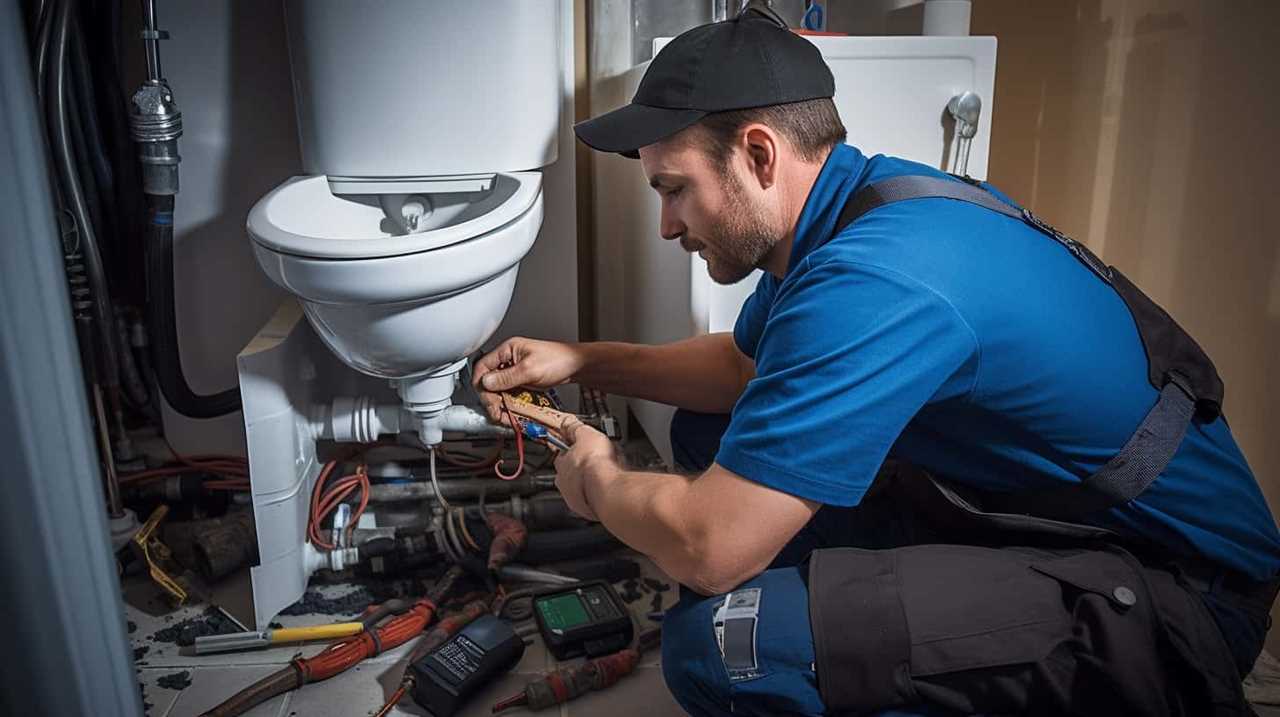We’ve all had that experience – standing in the bathroom, hearing the constant dripping noise, and questioning why the toilet tank is leaking.
Well, fear not, for we are here to shed light on this common household annoyance.
In this article, we will delve into the various culprits behind a leaking toilet tank, from faulty flapper valves to loose tank bolts.
So grab your tool kit and get ready to master the art of repairing your toilet with precision and ease.

Key Takeaways
- Flapper valve issues, such as wear and tear or sediment buildup, can cause water leakage in the toilet tank.
- Loose or rusty tank bolts can lead to water seepage and potential damage.
- Cracks in the tank or bowl can result in water leakage and may require temporary sealing or replacement.
- Malfunctioning fill valves can cause continuous water flow and leaks, which may need adjustment or replacement.
Faulty Flapper Valve
A faulty flapper valve can cause a toilet tank to leak. Flapper valves are essential components that regulate the flow of water from the tank to the toilet bowl. Over time, these valves can deteriorate or become misaligned, leading to leaks. Regular flapper valve maintenance is crucial for preventing such issues.
One common cause of a faulty flapper valve is wear and tear. The constant opening and closing of the valve can cause it to weaken or develop cracks, resulting in water leakage.
Another frequent cause is sediment buildup. Mineral deposits and debris can accumulate on the flapper valve, preventing it from creating a proper seal.
Loose or Damaged Tank Bolts
Loose or damaged tank bolts can contribute to toilet tank leaks. When the tank bolts become loose, water can seep through the gaps and cause leakage. Additionally, rusty hardware can weaken the bolts, leading to further instability and potential leaks. It’s important to regularly check and tighten the tank bolts to prevent this issue.

In some cases, damaged tank bolts may result in an unstable toilet base. This instability can cause water to leak from the tank onto the floor, leading to potential water damage and costly repairs. Therefore, it’s crucial to address loose or damaged tank bolts promptly to maintain the integrity of your toilet system.
Now, let’s move on to the next section about the potential issue of a cracked tank or bowl.
Cracked Tank or Bowl
Moving on from the previous subtopic of loose or damaged tank bolts, another potential issue that can cause toilet tank leaks is a cracked tank or bowl. A crack in the tank or bowl can lead to water leakage, causing damage to the surrounding area and wasting water. Here are the signs and symptoms to look out for:
- Visible cracks: Inspect the tank and bowl for any visible cracks, which can occur due to age or impact.
- Water puddles: Notice any water puddles forming around the base of the toilet or on the floor, indicating a leak.
- Continuous water running: If the toilet constantly runs, it may be a result of a crack that’s causing water to continuously escape.
If you suspect a cracked tank or bowl, there are potential repair options available. These may include using epoxy putty or silicone caulk to seal the crack temporarily, or replacing the entire tank or bowl for a long-term solution.

Malfunctioning Fill Valve
After inspecting for a cracked tank or bowl, the next potential cause of toilet tank leaks is a malfunctioning fill valve. The fill valve is responsible for refilling the tank after each flush. When it malfunctions, it can lead to continuous water flow, resulting in a leak.
To troubleshoot a malfunctioning fill valve, start by checking the water level in the tank. If it’s too high or too low, adjust the float to the correct position. Another common issue is a worn-out valve seal. In this case, replacing the seal should solve the problem.
If the fill valve is still malfunctioning after these steps, it may need to be replaced entirely. By addressing these common toilet tank issues related to the fill valve, you can prevent leaks and maintain a properly functioning toilet.
Improper Water Level Adjustment
To properly adjust the water level in the toilet tank, we need to follow a few simple steps.

- Check the water level: Before making any adjustments, it’s important to determine the current water level in the tank. This can be done by removing the tank lid and observing the water level mark.
- Adjust the float: The float is responsible for controlling the water level in the tank. If the water level is too high, adjust the float by bending the float arm downwards. If the water level is too low, bend the float arm upwards.
- Test and monitor: After making the necessary adjustments, flush the toilet and observe the water level. It should now be at the desired level. Monitor the tank over the next few days to ensure that the water level remains consistent.
Common mistakes in water level adjustment include not checking the water level before making adjustments, improper adjustment of the float, and failing to monitor the water level after making changes.
Proper maintenance of the water level in the toilet tank is crucial to prevent leaks and ensure efficient functioning.
Frequently Asked Questions
How Can I Prevent My Toilet Tank From Leaking in the First Place?
To prevent toilet tank leaks, we should focus on regular toilet tank maintenance. By inspecting for signs of potential leaks, such as water pooling around the base or a constantly running toilet, we can address issues promptly and avoid costly repairs.
Are There Any Temporary Fixes for a Leaking Toilet Tank Before I Can Get It Professionally Repaired?
There are temporary fixes for a leaking toilet tank that can be done as DIY repairs. These quick solutions can help prevent further damage until you can get it professionally repaired.

Can a Leaking Toilet Tank Cause Any Damage to My Bathroom or Home?
Potential water damage from a leaking toilet tank is a serious concern. Regular maintenance is crucial to prevent such leaks and protect your bathroom and home from costly repairs.
How Can I Determine if the Problem Is With the Toilet Tank or the Connecting Pipes?
To determine the cause of a toilet tank leak, we’ll follow troubleshooting steps. First, check the tank’s components for cracks or loose connections. If that’s not the issue, we’ll move on to inspecting the connecting pipes.
Is There a Way to Detect a Leaking Toilet Tank Without Having to Wait for Visible Signs of Water Dripping or Pooling?
Toilet tank maintenance is crucial to prevent leaks. Early signs of toilet tank leaks include high water bills, ghost flushing, and a constantly running toilet. Regularly inspecting and maintaining the tank can help detect leaks before visible signs appear.
Conclusion
Toilet tank leaks can be caused by various factors such as:

- A faulty flapper valve
- Loose or damaged tank bolts
- A cracked tank or bowl
- A malfunctioning fill valve
- Improper water level adjustment
It’s estimated that 20% of household toilets have some form of water leakage, resulting in wasted water and increased water bills. Therefore, addressing and fixing these issues promptly is essential to conserve water and save money.










